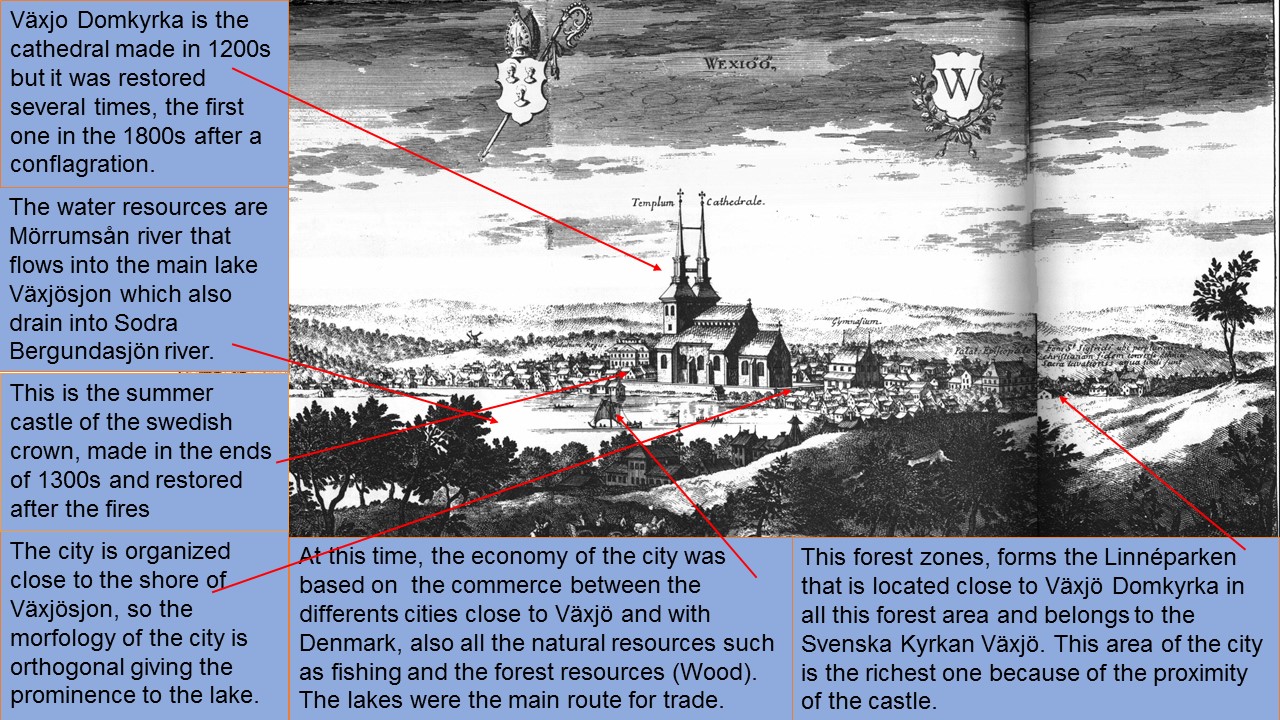This image is an engraving of the city of Växjö in 1690-1710 made by Erik Dahlberg that could be found at his publication Svecia Antiqua et Modierna. Erik Dahlberg was an engineer, soldier and Swedish field Marshall, who started to name himself Jönnson once he was made a knight. His work Svecia Antiqua et Modierna is a collection of paintings and drawing of Swedish castles and cathedrals, made by himself and published in 1698. Now it is preserved at the National Library of Sweden.
Växjö is a city in the middle of Smaland, in the south of Sweden, that today has a population of 60,200 habitants. The origin of the name is based on the location of the city and it means «road between lakes». Växjö has four lakes, the main one is Växjösjon and the river that flows into it is the Mörrumsan river; also the lake drain into Sodra Bergundasjön river so the ancient city was completely bordered by water.
In the engraving, it can be seen the Växjösjon lake and the cathedral of the city, which is so close to the shore. The cathedral was made in the middle of the 12th century but it has been renovated after 2 fires, although there are some pieces of Vikings ages. Today the Växjö domkyrka maintain the characteristic two towers from the 12th century even the renovation changed the general style into the Imperial one. The original church was formerly located in a peninsula, but the surrounding lake has lowered, so the cathedral is now surrounded by a large, green and inviting park area named Linnaeus park.
Close to Växjö domkyrka we could appreciate the Gymnasium or high school. Following its educational inspiration, today the city has one of the most important univeristies in Smaland, the Linnéuniversitetet. In the engraving we could also appreciate the Summer Castle of the Swedish crown. It was built at the end of 1300 but because of the fires and invasions, the style of the castle has changed to neoclassical. It is worth mentioning that in the near square there is a little market every Wednesday to be sold a lot of typical products from the area.
The morphology of the city is orthogonal after the renovations occured in the Imperial era. A new structuring planning forced this morphology and obey to reconstruct some buildings into a modern architecture. Nowadays the center of the city is moved in to the proximities of the railway station and the Town Hall, which is located close to the Summer Castle. The richest area was the closest to the castle and the church, and has diferences between the type of houses, in the poorest area were smaller houses as it is seen on the left part of the picture and the richest on the right which seems looks bigger than the others. But today the center of Växjö is just a commercial and business district, and the different neighborhoods are close to Linnéuniversitet, Trummen lakeand Linneparken, and the train station in where is located the most important residential quarters.
Thanks to the proximity to the lake, the main activity in the city was a very important commerce between Sweden and Denmark, especially when the Växjösjon was freeze in the winter months. Also, it is needed to mention that the geographical location and the influence of nature made this city one of the greenest of Europe and an ecofriendly city in where the technology and all the resources are totally respectful with the environment.
Sara García

